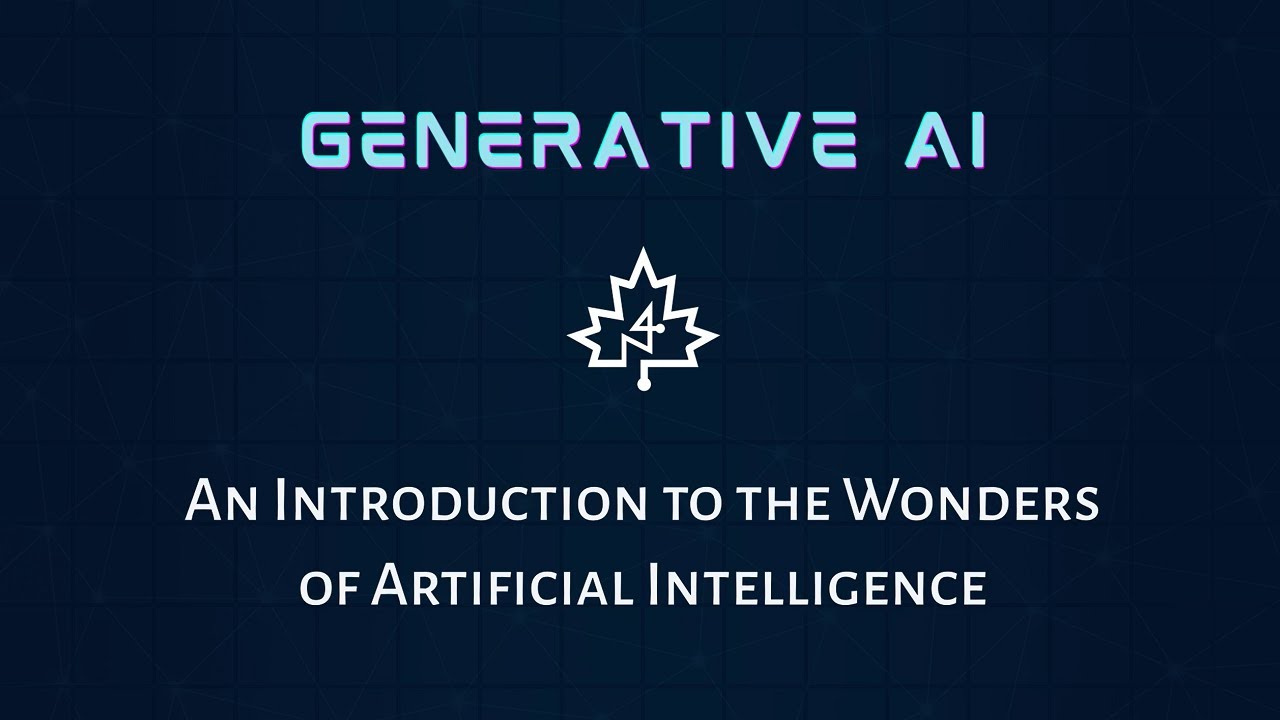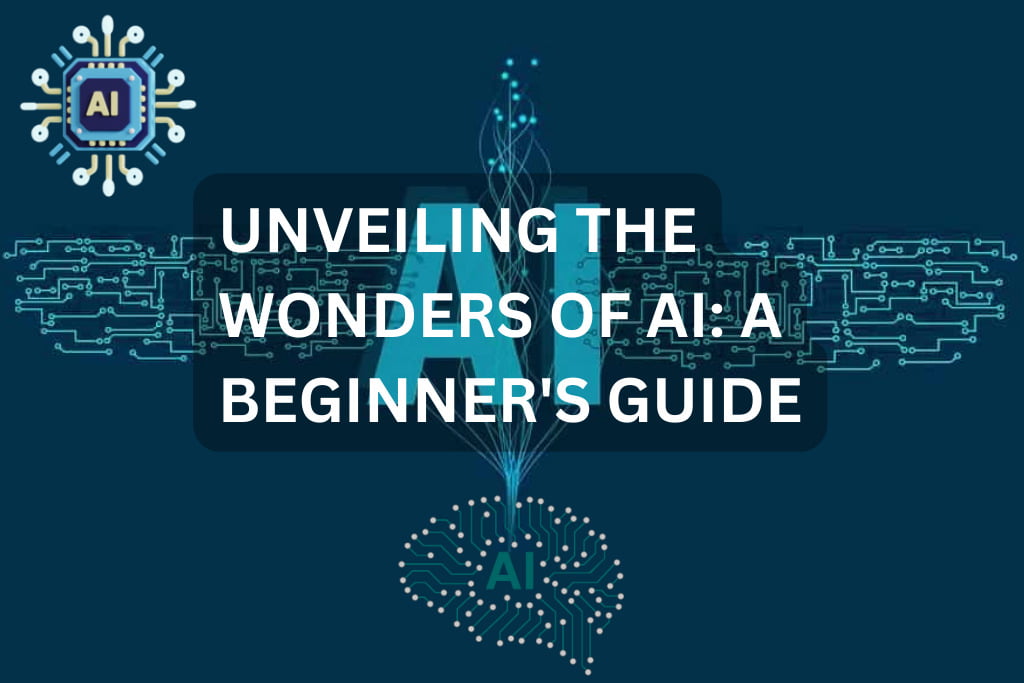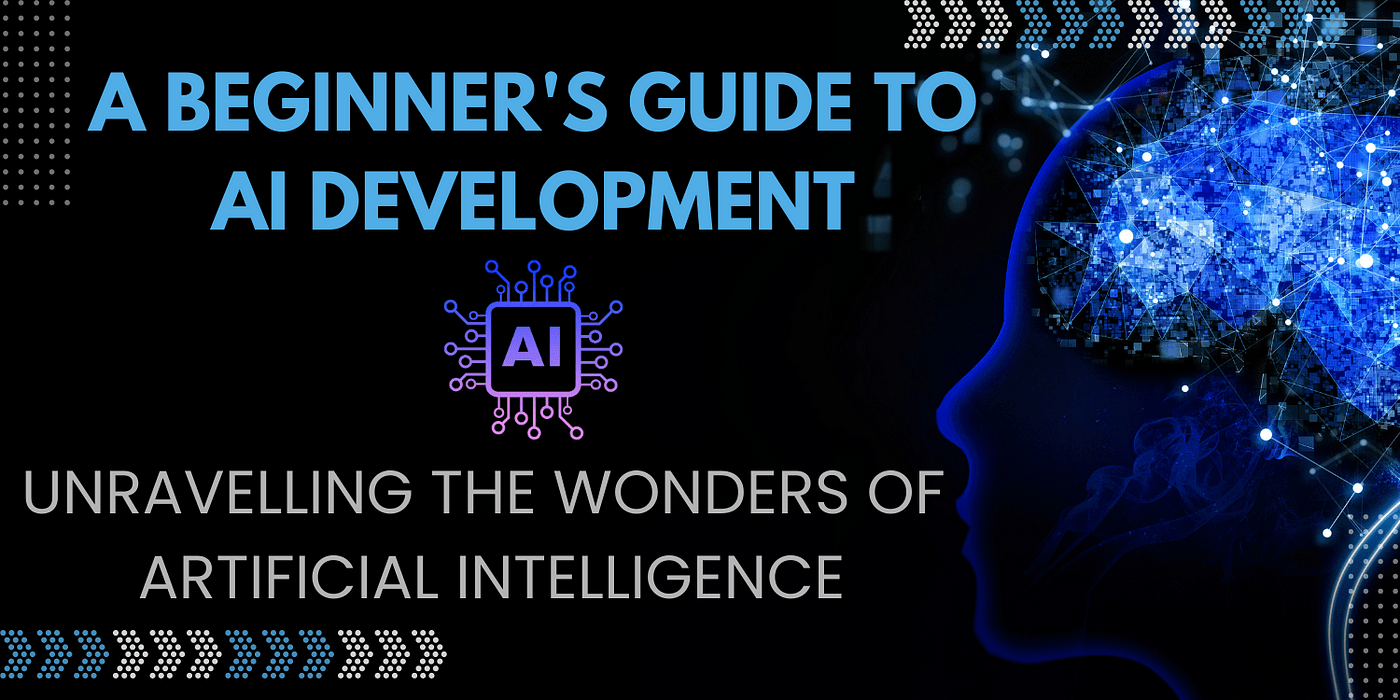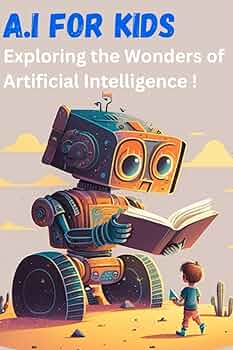Step into the captivating world of Artificial Intelligence (AI) as we embark on a journey to unravel its wonders. In this beginner’s guide, you will discover the fascinating realm of AI and understand how it is shaping our everyday lives. From self-driving cars to smart virtual assistants, AI has permeated every aspect of modern technology, revolutionizing the way we live, work, and interact with our surroundings. So, fasten your seatbelts and get ready to explore the incredible capabilities and endless possibilities of AI!

What is Artificial Intelligence
Artificial Intelligence (AI) is a branch of computer science that focuses on creating intelligent machines capable of performing tasks that typically require human intelligence. These tasks include speech recognition, decision-making, problem-solving, learning, and understanding natural language. AI aims to develop computer systems that can simulate human intelligence and exhibit characteristics like reasoning, knowledge representation, planning, and perception.
Defining Artificial Intelligence
Artificial Intelligence can be defined as the science and engineering of creating intelligent computer systems that can perform tasks requiring human intelligence. These tasks can range from simple calculations to complex problem-solving and decision-making.
Differentiating AI from human intelligence
While AI aims to mimic human intelligence, it is essential to understand the differences between AI and human intelligence. AI systems are designed to process vast amounts of data and perform specific tasks efficiently. However, they lack certain attributes associated with human intelligence, such as emotions, creativity, and common sense reasoning.
The history of Artificial Intelligence
The concept of AI has intrigued humans for centuries, but its practical development began in the mid-20th century. In 1956, the field of AI was officially established at the Dartmouth Conference, where researchers gathered to explore the possibilities of creating intelligent machines. Over the years, AI has gone through periods of intense research and development, known as “AI winters,” followed by resurgences. Significant milestones in AI history include the development of expert systems, the emergence of machine learning, and the advancements in deep learning.
Types of Artificial Intelligence
AI can be classified into different types based on its capabilities and functionalities.
Narrow AI
Narrow AI, also known as weak AI, refers to AI systems designed to perform a specific task or a set of tasks. These systems excel in a particular domain but lack generalized intelligence. Examples of narrow AI include voice assistants, recommendation algorithms, and image recognition systems.
General AI
General AI, also known as strong AI or human-level AI, refers to AI systems capable of performing any intellectual task that a human can do. General AI possesses human-like intelligence and can understand, learn, and apply knowledge across various domains. While still in the realm of science fiction, researchers continue to explore the development of general AI.
Superintelligent AI
Superintelligent AI refers to AI systems that surpass human intelligence in every aspect. These hypothetical systems would possess advanced problem-solving abilities and exhibit cognition far superior to any human mind. Superintelligent AI is a topic of intense debate and speculation, as its development could have profound consequences for humanity.
Applications of Artificial Intelligence
The applications of AI are vast and diverse, extending to various fields and industries.
Machine Learning in AI
Machine Learning is a subset of AI that focuses on enabling computers to learn from data and improve their performance without being explicitly programmed. It involves creating algorithms and models that can identify patterns, make predictions, and analyze complex datasets. Machine Learning finds applications in areas like image recognition, fraud detection, and personalized recommendations.
Natural Language Processing (NLP)
Natural Language Processing is a field of AI that deals with the interaction between computers and human language. NLP enables machines to understand, interpret, and generate human language, facilitating tasks like speech recognition, language translation, and sentiment analysis. Applications of NLP range from virtual assistants to chatbots and language translation services.
Computer Vision
Computer Vision involves enabling machines to perceive and interpret visual information from digital images or videos. It allows computers to understand and analyze visual data, enabling tasks like object detection, facial recognition, and autonomous navigation. Computer Vision finds applications in various domains, including surveillance systems, autonomous vehicles, and medical image analysis.
Robotics and Automation
AI plays a crucial role in robotics and automation by enhancing the capabilities of robots and enabling them to perform complex tasks. AI-powered robots can navigate environments, interact with objects, and adapt to changing situations. Industrial robots automate repetitive and mundane tasks, improving productivity and efficiency in industries such as manufacturing and logistics.
AI in Healthcare
AI has the potential to revolutionize healthcare by enabling more accurate diagnosis, personalized treatment plans, and improved patient outcomes. AI algorithms can analyze medical data, detect patterns, and provide insights to support clinical decision-making. Applications of AI in healthcare include disease prediction, medical imaging analysis, drug development, and virtual healthcare assistants.
AI in Finance
AI is transforming the finance industry through its ability to analyze vast amounts of financial data, detect fraudulent activities, and automate financial processes. AI algorithms can identify patterns and anomalies in financial transactions, assess creditworthiness, and provide personalized financial advice. Applications of AI in finance include algorithmic trading, risk assessment, fraud detection, and customer service chatbots.
AI in Transportation
AI is driving innovation in the transportation industry, enabling the development of autonomous vehicles and efficient transportation systems. AI algorithms can process sensor data, analyze traffic patterns, and make real-time decisions to optimize routes and reduce congestion. Autonomous vehicles powered by AI have the potential to improve safety, reduce accidents, and enhance transportation accessibility.
AI in Customer Service
AI-powered customer service solutions, such as chatbots and virtual assistants, are revolutionizing the way businesses interact with their customers. These intelligent systems can understand natural language, provide instant responses, and assist customers with their queries and issues. AI in customer service improves response times, enhances customer satisfaction, and enables businesses to scale their support operations.
AI in Education
AI is transforming the education landscape by providing personalized learning experiences, automating administrative tasks, and enabling intelligent tutoring systems. Adaptive learning platforms powered by AI can assess students’ strengths and weaknesses, tailor educational content, and provide customized learning paths. AI also facilitates automation of administrative tasks like grading and scheduling, freeing up educators’ time for more impactful teaching.
AI in Entertainment and Gaming
AI is enhancing the entertainment and gaming industries by enabling realistic simulations, immersive experiences, and intelligent game design. AI algorithms can generate realistic graphics, simulate physics, and create interactive narratives. Additionally, AI-powered game agents can provide challenging opponents, adapt gameplay to players’ skills, and generate engaging content dynamically.
Benefits and Impacts of AI
AI has significant benefits and impacts across various aspects of society and industries.
Increased efficiency and productivity
Deploying AI systems in industries and businesses can greatly improve efficiency and productivity. AI-powered automation can handle repetitive tasks, reducing human error and enabling faster processing. This allows organizations to focus on more complex and value-added activities.
Improved decision-making
AI algorithms can process and analyze vast amounts of data, enabling organizations to make informed and data-driven decisions. AI-based predictive models can identify patterns and trends, helping businesses anticipate market changes, optimize operations, and improve strategic planning.
Enhanced customer experience
AI technologies, such as chatbots and virtual assistants, provide personalized and instant customer support. By understanding customer queries and preferences, AI systems can deliver tailored recommendations and solutions, leading to improved customer satisfaction and loyalty.
Transforming industries
AI is transforming various industries, driving innovation and shaping new business models. Industries like healthcare, finance, transportation, and manufacturing are experiencing significant advancements and efficiencies through the adoption of AI. This transformative impact unlocks new opportunities and challenges existing norms.
Challenges and ethical considerations
While AI offers immense potential, it also poses challenges and ethical considerations. Concerns regarding bias in AI algorithms, privacy concerns, job displacement due to automation, and the impact of AI on human interactions need to be addressed for responsible and ethical AI development.

How AI Works
Understanding how AI works provides insights into the underlying mechanisms and technologies driving intelligent systems.
Data collection and preprocessing
AI systems rely on vast amounts of data to learn and make accurate predictions. Data collection involves gathering relevant and representative datasets, followed by preprocessing to clean and prepare the data for analysis.
Machine Learning algorithms
Machine Learning algorithms form the core of AI systems. These algorithms enable machines to learn from data, identify patterns, and make predictions. Supervised learning, where algorithms learn from labeled data, and unsupervised learning, where algorithms analyze unlabeled data, are two common approaches in Machine Learning.
Deep Learning and Neural Networks
Deep Learning is a subset of Machine Learning that mimics the functioning of the human brain using artificial neural networks. Neural networks consist of interconnected layers of artificial neurons that process and analyze data, enabling complex pattern recognition and decision-making.
Training vs. Inference
In the training phase, AI models are exposed to data to learn and optimize their performance. This involves adjusting the model’s parameters and weights based on the observed data. Inference refers to the deployment of trained models to make predictions or perform specific tasks on new, unseen data.
Supervised, Unsupervised, and Reinforcement Learning
Supervised Learning involves training AI models using labeled data, where the desired output is known. Unsupervised Learning focuses on finding patterns and structures in unlabeled data, allowing the AI system to learn without explicit labels. Reinforcement Learning involves rewarding an AI agent for making correct decisions or following desired behaviors, enabling it to learn through trial and error.
AI models and frameworks
AI models and frameworks are tools and platforms that facilitate the development and deployment of AI systems. These frameworks provide libraries, algorithms, and APIs that enable researchers and developers to build complex AI models and applications efficiently.
Ethical Considerations in AI
As AI becomes more intertwined with daily life, addressing ethical considerations is vital for responsible and sustainable AI development.
Bias in AI algorithms
AI algorithms can be susceptible to bias, as they learn from historical data that may contain inherent biases. This can result in biased decision-making and discrimination. Efforts must be made to minimize and mitigate bias in AI algorithms to ensure fairness and equal treatment.
Privacy concerns
The use of AI systems often involves handling vast amounts of personal data, raising concerns about privacy and data security. Safeguarding sensitive information and ensuring compliance with data protection regulations are crucial ethical considerations in AI development.
Job displacement
As AI automation replaces certain job roles, concerns arise regarding the displacement of human workers. Addressing this issue involves creating new job opportunities, reskilling and upskilling the workforce, and ensuring a fair transition to an AI-driven economy.
AI and human interactions
Consideration must be given to the impact of AI on human interactions and relationships. Human-machine interactions should be designed to uphold ethical standards, respect privacy, and foster trust. Striking the right balance between human involvement and AI capabilities is essential for responsible AI development.
Regulation and accountability
As AI becomes increasingly prevalent, establishing regulations and frameworks for accountability and transparency becomes crucial. Policies and guidelines should be in place to ensure ethical usage and prevent AI misuse that may endanger society or violate human rights.
The Future of AI
The future of AI holds immense potential and raises important questions about its impact on society.
Advancements in AI technology
Advancements in AI technology are expected to continue at a rapid pace. Breakthroughs in areas like deep learning, neural networks, and natural language processing will fuel the development of more sophisticated AI systems with enhanced capabilities.
AI in everyday life
AI is gradually becoming a ubiquitous part of everyday life. From the personalized recommendations we receive on streaming platforms to the voice assistants that help us manage our daily tasks, AI technologies are integrating seamlessly into our routines.
Potential risks and opportunities
While AI presents numerous opportunities, it also poses risks. Ethical challenges, job displacement, and the potential for misuse are areas that require careful consideration. Efforts should be made to leverage AI’s potential for societal benefit while mitigating potential risks.
Collaboration between AI and humans
The future of AI lies in collaborations between AI systems and humans. Rather than replacing humans, AI can augment human capabilities and assist in decision-making, problem-solving, and productivity. Emphasizing human oversight and control will ensure responsible and beneficial deployment of AI systems.
Ethical guidelines and responsible AI development
As AI continues to evolve, establishing ethical guidelines and promoting responsible AI development becomes crucial. Collaboration between researchers, policymakers, and stakeholders is essential to define ethical frameworks, regulations, and best practices that govern AI development and usage.
Getting Started with AI
For individuals interested in exploring AI, getting started requires foundational knowledge and resources.
Prerequisites and basic knowledge
Basic knowledge of computer programming and mathematics forms the foundation for understanding AI concepts. Familiarity with programming languages like Python, knowledge of statistics, and linear algebra are beneficial for grasping AI principles.
Resources for learning AI
Numerous resources are available for learning AI, ranging from online courses, tutorials, books, and research papers. Online platforms like Coursera, edX, and Udacity offer comprehensive AI courses taught by experts in the field. Accessing research papers and AI conferences provides insights into cutting-edge developments in the field.
Programming languages and tools
Python is a popular programming language widely used in AI development due to its simplicity and rich ecosystem of libraries and frameworks. Libraries like TensorFlow and PyTorch provide powerful tools for implementing Machine Learning and deep learning algorithms.
Online courses and tutorials
Online courses and tutorials offer a structured way to learn AI concepts and gain practical experience. These resources provide hands-on projects, coding exercises, and real-world examples to reinforce learning.
Hands-on projects and experimentation
Building AI projects is an effective way to apply knowledge and gain practical experience. Engaging in projects like image classification, sentiment analysis, or chatbot development helps develop skills and understand AI principles in practice.

Famous AI Examples
Several well-known AI systems have made significant advancements in their respective domains.
IBM’s Watson
IBM’s Watson is an AI-powered system that gained recognition by winning the quiz show Jeopardy! in 2011. Watson utilizes natural language processing and Machine Learning to process vast amounts of data and provide accurate answers to complex queries.
Google Assistant
Google Assistant is a popular virtual assistant powered by AI. It uses natural language processing and machine learning algorithms to understand user queries, provide personalized recommendations, and perform tasks like setting reminders, making reservations, and answering questions.
Self-driving cars
Self-driving cars, enabled by AI, have gained traction as the future of transportation. AI algorithms analyze sensor data from cameras, radars, and lidars to navigate roads, detect obstacles, and make real-time driving decisions.
Virtual Assistants
Virtual assistants like Amazon’s Alexa, Apple’s Siri, and Microsoft’s Cortana employ AI algorithms to understand natural language queries and perform tasks like playing music, controlling smart home devices, and providing information.
Fraud detection systems
AI algorithms are extensively used in fraud detection systems across industries. By analyzing transactional patterns, user behavior, and historical data, AI-powered systems can identify suspicious activities and prevent fraud.
Recommendation algorithms
AI-powered recommendation algorithms are employed in various platforms to personalize user experiences. These algorithms analyze user preferences, behavior, and historical data to provide tailored recommendations for products, movies, music, and more.
Conclusion
Artificial Intelligence is a fascinating field of research and development with far-reaching implications. It has the potential to revolutionize industries, transform how we live and work, and augment human capabilities. Understanding the fundamentals of AI, exploring its applications, considering ethical considerations, and engaging in hands-on learning will empower individuals to navigate the AI landscape and contribute to its responsible and beneficial development. So, embrace the wonders of AI, immerse yourself in its possibilities, and join the exciting journey of exploring the potential of artificial intelligence.







Leave a Reply